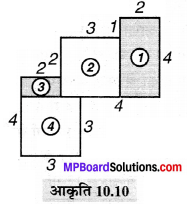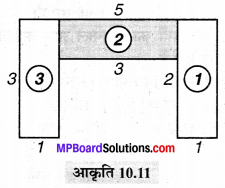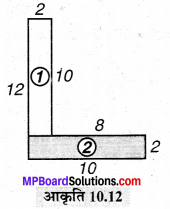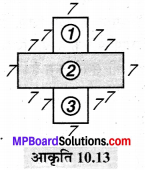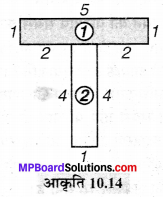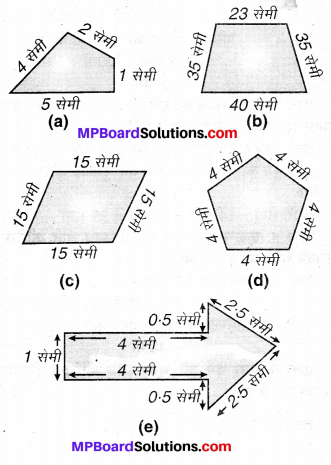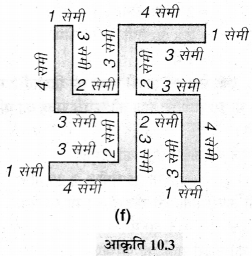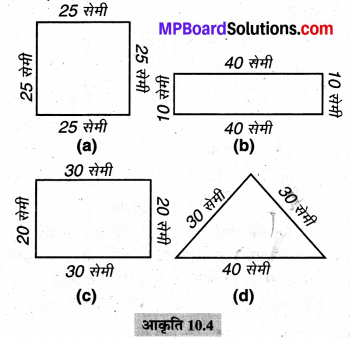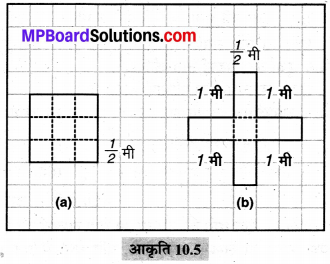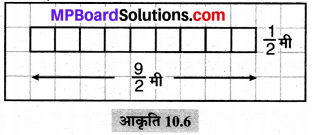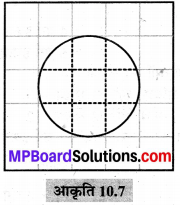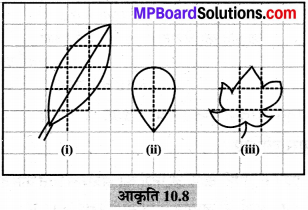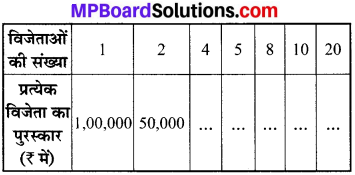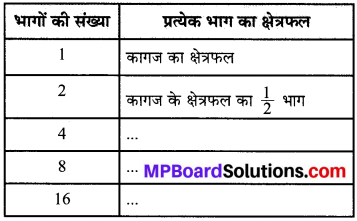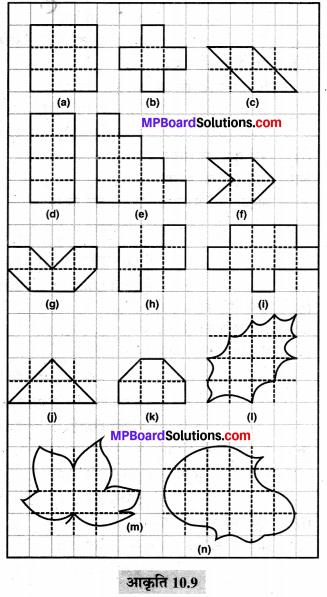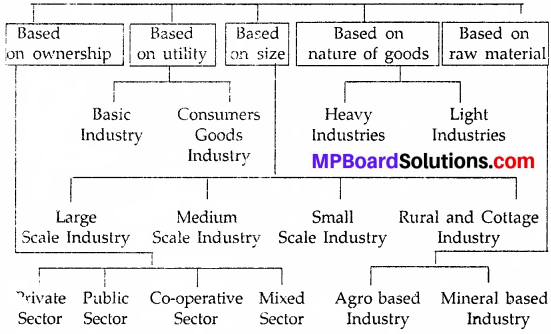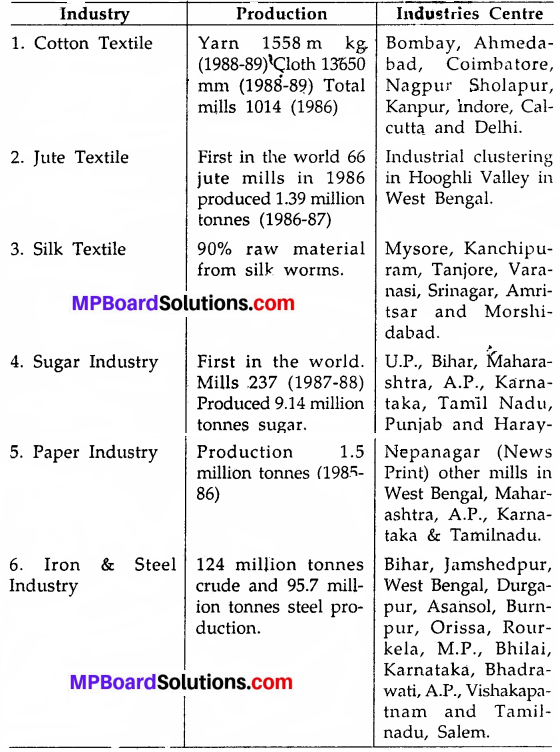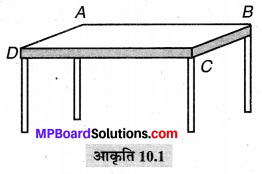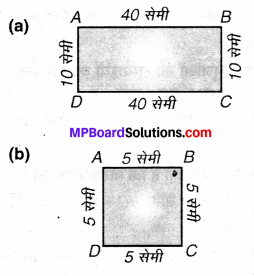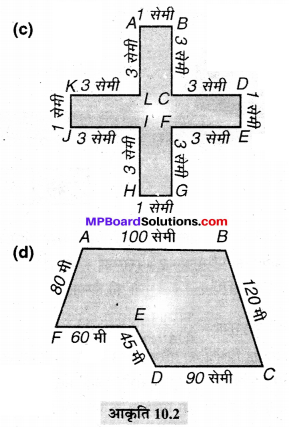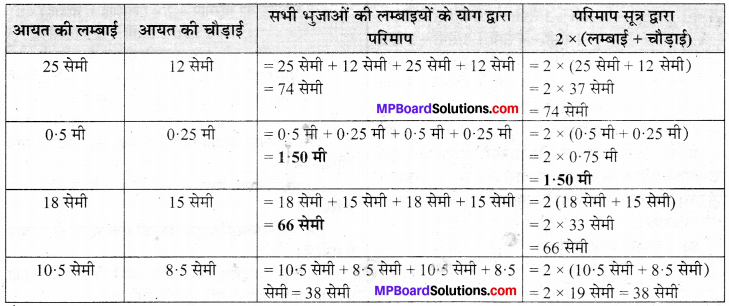MP Board Class 6th Maths Solutions Chapter 11 बीजगणित Ex 11.1
पाठ्य-पुस्तक पृष्ठ संख्या # 246-247
प्रश्न 1.
तीलियों से प्रतिरूप बनाने के लिए आवश्यक तीलियों की संख्या के लिए नियम ज्ञात कीजिए। नियम लिखने के लिए एक चर का प्रयोग कीजिए।
(a) अक्षर T का T के रूप में तीलियों से प्रतिरूप
(b) अक्षर Z का Z के रूप में तीलियों से प्रतिरूप
(c) अक्षर U का U के रूप में तीलियों से प्रतिरूप
(d) अक्षर V का V के रूप में तीलियों से प्रतिरूप
(e) अक्षर E का E के रूप में तीलियों से प्रतिरूप
(f) अक्षर S का S के रूप में तीलियों से प्रतिरूप
(g) अक्षर A का A के रूप में तीलियों से प्रतिरूप
हल :
(a)

आवश्यक तीलियों की संख्या
n = 1 के लिए = 2 या 2n
n = 2 के लिए = 4 या 2n
n = 3 के लिए = 6 या 2n
∴नियम : 2n
(b)

आवश्यक तीलियों की संख्या
n = 1 के लिए = 3 या 3n
n = 2 के लिए = 6 या 3n
n = 3 के लिए = 9 या 3n
∴नियम : 3n
(c)

आवश्यक तीलियों की संख्या
n = 1 के लिए = 3 या 3n
n = 2 के लिए = 6 या 3n
n = 3 के लिए = 9 या 3n
∴नियम : 3n
(d)

आवश्यक तीलियों की संख्या
n = 1 के लिए = 2 या 2n
n = 2 के लिए = 4 या 2n
n = 3 के लिए = 6 या 2n
∴नियम : 2n
(e)

आवश्यक तीलियों की संख्या
n = 1 के लिए = 5 या 5n
n = 2 के लिए = 10 या 5n
n = 3 के लिए = 15 या 5n
∴नियम : 5n
(f)

आवश्यक तीलियों की संख्या
n = 1 के लिए = 5 या 5n
n = 2 के लिए = 10 या 5n
n = 3 के लिए = 15 या 5n
∴नियम : 5n
(g)

आवश्यक तीलियों की संख्या
n = 1 के लिए = 6 या 6n
n = 2 के लिए = 12 या 6n
n = 3 के लिए = 18 या 6n
∴नियम : 6n
![]()
प्रश्न 2.
हम अक्षर L, C और F के प्रतिरूपों के लिए नियमों को पहले से जानते हैं। ऊपर प्रश्न 1 में दिए कुछ अक्षरों से वही नियम प्राप्त होता है जो L द्वारा प्राप्त हुआ था। ये अक्षर कौन-कौन-से हैं ? ऐसा क्यों होता है ?
हल :
माचिस की तीलियों से संख्या प्राप्त करने के लिए नियम निम्नांकित हैं :
अक्षर L के लिए 2n
अक्षर C के लिए 3n
अक्षर V के लिए 2n
अक्षर U के लिए 3n
अक्षर T के लिए 2n
अक्षर F के लिए 4n
∴यह L, V और T के लिए समान है। इन सभी अक्षरों में माचिस की तीलियों की आवश्यक संख्या 2 है।
प्रश्न 3.
किसी परेड में कैडेट (Cadets) मार्च (march) कर रहे हैं। एक पंक्ति में 5 कैडेट हैं। यदि पंक्तियों की संख्या ज्ञात हो, तो कैडेटों की संख्या ज्ञात करने के लिए क्या नियम हैं ?
(पंक्तियों की संख्या के लिए n का प्रयोग कीजिए।)
हल :
पंक्तियों की संख्या = n
प्रत्येक पंक्ति में कैडेट की संख्या = 5
अतः नियम : परेड में कैडेटों की संख्या = 5n
प्रश्न 4.
एक पेटी में 50 आम हैं। आप पेटियों की संख्या के पदों में आमों की कुल संख्या को किस प्रकार लिखेंगे ? (पेटियों की संख्या के लिए b का प्रयोग कीजिए)।
हल :
एक पेटी में आमों की संख्या = 50
पेटियों की संख्या = b
∴आमों की कुल संख्या = 50b
प्रश्न 5.
शिक्षक प्रत्येक विद्यार्थी को 5 पेन्सिल देता है। विद्याथियों की संख्या ज्ञात होने पर, क्या आप कुल वांछित पेन्सिलों की संख्या बता सकते हैं ? (विद्यार्थियों की संख्या के लिए s का प्रयोग कीजिए।)
हल :
विद्यार्थियों की संख्या = s
प्रत्येक विद्यार्थी को पेन्सिल = 5
∴कुल पेन्सिलों की संख्या = 5s
प्रश्न 6.
एक चिड़िया 1 मिनट में 1 किलोमीटर उड़ती है। क्या आप चिड़िया द्वारा तय की गई दूरी को (मिनटों में) उसके उड़ने के समय के पदों में व्यक्त कर सकते हैं ? (मिनटों में उड़ने के समय के लिए t का प्रयोग कीजिए।)
हल :
चिड़िया 1 मिनट में एक किलोमीटर उड़ती है।
अब माना कि वह t मिनट उड़ती है
∴t मिनट में चिड़िया द्वारा तय की गई कुल दूरी
= 1 x t किलोमीटर
= t किलोमीटर
प्रश्न 7.
राधा बिन्दुओं (Dots) से एक रंगोली बना रही है। (खड़िया के पाउडर की सहायता से बिन्दुओं को जोड़कर रेखाओं का एक सुन्दर प्रतिरूप बनाना, जैसे आकृति में है।) उसके पास एक पंक्ति में 8 बिन्दु हैं। r पंक्तियों की रंगोली में कितने बिन्दु होंगे? यदि 8 पंक्तियाँ हों, तो कितने बिन्दु होंगे? यदि 10 पंक्तियाँ हों, तो कितने बिन्दु होंगे?
हल :
एक पंक्ति में बिन्दु = 8
पंक्तियों की संख्या = r
r पंक्तियों में बिन्दुओं की संख्या = 8r
8 पंक्तियों में बिन्दुओं की संख्या = 8 x 8 = 64
और, 10 पंक्तियों में बिन्दुओं की संख्या = 8 x 10 = 80
प्रश्न 8.
लीला राधा की छोटी बहन है। लीला राधा से 4 वर्ष छोटी है। क्या आप लीला की आयु राधा की आयु के पदों में लिख सकते हैं? राधा की आयु x वर्ष है।
हल :
राधा की आयु = x वर्ष
चूँकि लीला की आयु = राधा की आयु – 4 वर्ष
∴ लीला की आयु = x वर्ष – 4 वर्ष
= (x – 4) वर्ष
![]()
प्रश्न 9.
माँ ने लड्डू बनाए हैं। उन्होंने कुछ लड्डू मेहमानों और परिवार के सदस्यों को दिए। फिर भी 5 लड्डू शेष रह गये हैं। यदि माँ ने l लड्डू दे दिए हों, तो उसने कुल कितने लड्डू बनाए थे ?
हल :
शेष रहे लड्डुओं की संख्या = 5
मेहमानों और परिवार के सदस्यों को दिए लड्डूओं की संख्या = l
∴माँ द्वारा बनाए लड्डुओं की संख्या = l + 5
प्रश्न 10.
सन्तरों को बड़ी पेटियों में से छोटी पेटियों में रखा जाना है। जब एक बड़ी पेटी को खाली किया जाता है, तो उसके सन्तरों से दो छोटी पेटियाँ भर जाती हैं और फिर भी 10 सन्तरे शेष रह जाते हैं। यदि एक छोटी पेटी में सन्तरों की संख्या को x लिया जाए तो बड़ी पेटी में सन्तरों की संख्या क्या है?
हल :
बड़ी पेटी में सन्तरों की संख्या = 2 x छोटी पेटी में सन्तरों की संख्या + शेष सन्तरों की संख्या
= 2x + 10
प्रश्न 11.
(a) तीलियों से बने हुए वर्गों के नीचे दिए प्रतिरूपों को देखिए (निम्न आकृति)। ये वर्ग अलग-अलग नहीं हैं। दो संलग्न वर्गों में एक तीली उभयनिष्ठ है। इस प्रतिरूप को देखिए और वह नियम ज्ञात कीजिए जो वर्गों की संख्या के पदों में आवश्यक तीलियों की संख्या देता है। (संकेत : यदि आप अंतिम ऊर्ध्वाधर तीली को हटा दें, तो आपको C का प्रतिरूप प्राप्त हो जाएगा।)
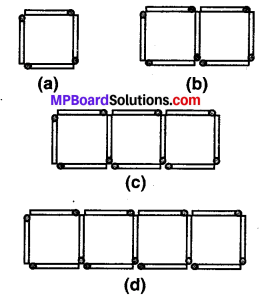
(b) निम्न आकृति तीलियों से बना त्रिभुजों का एक प्रतिरूप दर्शा रही है। उपर्युक्त प्रश्न 11(a) की तरह, वह व्यापक नियम ज्ञात कीजिए जो त्रिभुजों की संख्या के पदों में आवश्यक तीलियों की संख्या देता है।
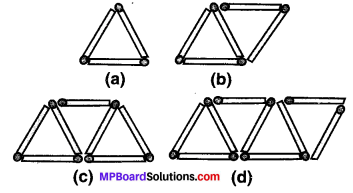
हल :
माना कि वर्गों की संख्या = n
(a) ∴ जबकि n = 1,
तीलियों की संख्या = 4 या 3 x 1 + 1 = 3n + 1
जबकि n = 2,
तीलियों की संख्या = 7 या 3 x 2 + 1 = 3n + 1
जबकि n = 3,
तीलियों की संख्या = 10 या 3 x 3 + 1 = 3n + 1
जबकि n = 4,
तीलियों की संख्या = 13 या 3 x 4 + 1 = 3n + 1
अत: वांछित नियम : 3n + 1
(b) माना कि त्रिभुजों की संख्या = n
जबकि n = 1,
तीलियों की संख्या = 3 या 2 x 1 + 1 = 2n + 1
जबकि n = 2,
तीलियों की संख्या = 5 या 2 x 2 + 1 = 2n + 1
जबकि n = 3,
तीलियों की संख्या = 7 या 2 x 3 + 1 = 2n + 1
जबकि n = 4,
तीलियों की संख्या = 9 या 2 x 4 + 1 = 2n + 1
अतः वांछित नियम : 2n + 1












